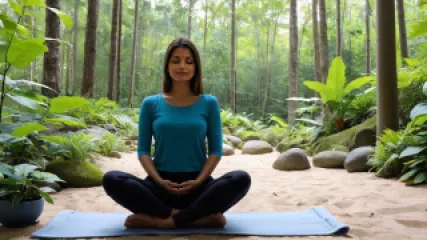Mastering Mindfulness: A Step-by-Step Guide to Reducing Anxiety
Mastering Mindfulness: A Step-by-Step Guide to Reducing Anxiety
In a world that often feels fast-paced and overwhelming, finding ways to manage anxiety can be a true challenge. However, the practice of mindfulness has emerged as a powerful tool for individuals seeking to regain control of their mental and emotional well-being. This comprehensive guide will walk you through the step-by-step process of mastering mindfulness techniques that can effectively reduce anxiety and help you cultivate a more centered, peaceful state of being.
Understanding Mindfulness and its Benefits
Mindfulness is the art of being fully present in the moment, without judgment or attachment to thoughts and emotions. It involves cultivating a heightened awareness of the here and now, rather than dwelling on the past or worrying about the future. This powerful practice has been shown to have a multitude of benefits, particularly when it comes to managing anxiety.
When we are mindful, we are better able to observe our thoughts and feelings from a detached, objective perspective. Rather than being consumed by anxious thoughts, we can simply acknowledge them and let them pass, without giving them undue attention or power. This can help to break the cycle of rumination and worry that often fuels anxiety.
Additionally, mindfulness has been linked to a range of physiological benefits that can help alleviate the physical symptoms of anxiety. Regular practice has been shown to reduce heart rate, lower blood pressure, and decrease the production of stress hormones like cortisol. By calming the body's stress response, mindfulness can help you feel more grounded, centered, and in control.
Perhaps most importantly, mindfulness can foster a greater sense of self-awareness and emotional regulation. By learning to observe our thoughts and emotions with compassion and non-judgment, we can develop a healthier relationship with our inner experiences. This, in turn, can lead to greater resilience, improved mood, and a greater capacity to navigate life's challenges with grace and equanimity.
The Foundations of Mindfulness Practice
Before delving into the specific techniques of mindfulness, it's important to establish a solid foundation for your practice. Here are some key principles to keep in mind as you embark on your mindfulness journey:
1. Presence
The essence of mindfulness is being fully present in the moment, without getting caught up in the past or future. This means cultivating a heightened awareness of your immediate surroundings, sensations, and inner experience, rather than letting your mind wander.
2. Acceptance
Mindfulness involves approaching your thoughts, feelings, and experiences with a non-judgmental attitude. Rather than criticizing or trying to change what is, you simply acknowledge it with compassion and acceptance.
3. Patience
Developing a mindfulness practice takes time and dedication. It's important to approach the process with patience and self-compassion, recognizing that it's a lifelong journey with ups and downs.
4. Beginner's Mind
Cultivating a "beginner's mind" means approaching each moment with a sense of openness and curiosity, rather than relying on preconceived notions or expectations. This can help you stay present and engaged, rather than getting stuck in habitual patterns of thinking.
5. Non-Doing
Mindfulness is not about achieving a particular goal or outcome; it's about the practice itself. Rather than striving or efforting, mindfulness involves a gentle, non-doing approach that allows you to simply be.
With these foundational principles in mind, you can begin to explore the specific mindfulness techniques that can help you reduce anxiety and cultivate greater inner peace.
Mindfulness Techniques for Anxiety Reduction
There are a variety of mindfulness practices that can be effective in managing anxiety. Here are some of the most powerful techniques to explore:
1. Breath Awareness
One of the most accessible and versatile mindfulness practices is breath awareness. By simply focusing your attention on the sensations of your breathing – the inhalation, the exhalation, the rise and fall of your belly – you can anchor yourself in the present moment and calm the mind.
To practice breath awareness, find a comfortable seated or lying position and begin to tune in to your breath. Notice the natural rhythm of your inhalations and exhalations, without trying to control or alter them. If your mind wanders, gently bring your attention back to the breath.
You can practice breath awareness for just a few minutes at a time, or incorporate it into a longer meditation session. Over time, this simple technique can help you cultivate a greater sense of calm and center in the face of anxiety.
2. Body Scan
Another powerful mindfulness practice is the body scan, which involves systematically tuning in to the sensations in different parts of the body. This can help you become more aware of physical tension or discomfort that may be contributing to your anxiety, and release it through deep relaxation.
To practice the body scan, begin by settling into a comfortable position and closing your eyes. Bring your attention to the sensations in your feet, noticing any feelings of warmth, coolness, or tingling. Slowly work your way up through your body, observing the sensations in your legs, hips, abdomen, chest, arms, and face. If you notice any areas of tension or discomfort, simply breathe into them and allow them to soften.
The body scan can be particularly helpful for individuals who experience physical symptoms of anxiety, such as muscle tightness, rapid heartbeat, or shallow breathing. By bringing awareness to these bodily experiences, you can start to release them and restore a sense of calm and ease.
3. Mindful Movement
While many mindfulness practices involve stillness and focused attention, mindful movement can also be a powerful tool for reducing anxiety. Activities like yoga, tai chi, or even simple walking can help you become more present and connected to your body, while also releasing physical tension and stress.
When practicing mindful movement, the key is to approach it with the same sense of non-judgment and presence that you would bring to a seated meditation. Focus on the sensations in your body as you move, being fully aware of each gesture, breath, and transition. If your mind starts to wander, gently bring your attention back to the movement.
Mindful movement can be particularly helpful for individuals who find it challenging to sit still or who need a more active outlet for their anxiety. By combining physical activity with mindful awareness, you can experience the benefits of both – a calmer mind and a more relaxed, balanced body.
4. Sensory Awareness
Tuning in to your senses can be a powerful way to anchor yourself in the present moment and interrupt the anxious thought patterns that can fuel anxiety. By focusing your attention on what you see, hear, smell, taste, or feel in the here and now, you can shift your awareness away from worries about the past or future.
To practice sensory awareness, simply take a few moments to notice your surroundings with heightened attention. What colors, shapes, or textures do you observe? What sounds or smells are present? What sensations are you experiencing in your body? Avoid judging or analyzing these sensory experiences – simply observe them with a curious, open mind.
Sensory awareness can be particularly helpful during moments of acute anxiety, when your mind may be racing and you need a way to quickly ground yourself. By tuning in to your senses, you can interrupt the cycle of anxious thoughts and regain a sense of calm and control.
5. Visualization and Imagery
The power of the mind is a remarkable thing, and visualization and imagery can be powerful tools for managing anxiety. By creating vivid mental pictures of calming, peaceful scenes, you can shift your focus away from anxious thoughts and induce a state of relaxation and well-being.
To practice visualization, take a few deep breaths and close your eyes. Imagine a place that feels safe, soothing, and serene – perhaps a tranquil beach, a lush forest, or a cozy, comfortable room. Engage all of your senses as you visualize this scene, noticing the colors, sounds, smells, and textures. Allow yourself to fully immerse in the experience, feeling the tension and anxiety melt away.
You can also use imagery to visualize specific outcomes or experiences that you desire, such as feeling calm and centered in the face of a challenging situation. By creating these positive mental representations, you can start to reprogram your mind and build confidence in your ability to manage anxiety.
Integrating Mindfulness into Daily Life
While the mindfulness techniques outlined above can be powerful tools for reducing anxiety, the true power of mindfulness lies in making it a consistent part of your daily life. Here are some tips for integrating mindfulness into your routine:
1. Start Small
Don't feel like you need to overhaul your entire lifestyle to reap the benefits of mindfulness. Start with just a few minutes of practice each day, whether it's a brief breathing exercise or a simple body scan. Over time, you can gradually increase the duration and frequency of your mindfulness sessions.
2. Find What Works for You
Experiment with different mindfulness techniques to see what resonates with you the most. Some people may prefer the stillness of seated meditation, while others may thrive with more dynamic practices like mindful movement. Pay attention to what makes you feel most grounded, calm, and centered.
3. Incorporate Mindfulness into Daily Activities
Mindfulness doesn't have to be confined to a dedicated practice session. Look for opportunities to bring present-moment awareness to your everyday routines, such as washing dishes, taking a shower, or walking from one room to another. This can help you cultivate a more mindful, grounded state throughout the day.
4. Foster Self-Compassion
Practicing mindfulness often involves acknowledging and accepting difficult emotions, rather than suppressing or avoiding them. It's important to approach this process with self-compassion, recognizing that anxiety and other challenging experiences are a natural part of the human experience.
5. Seek Support
While mindfulness can be a powerful tool for self-care, it's important to recognize when additional support may be needed. Consider joining a mindfulness-based support group, working with a therapist or counselor, or exploring other resources that can help you on your journey.
Conclusion: Embracing the Power of Mindfulness
In a world that often feels overwhelming and uncertain, the practice of mindfulness offers a profound path towards greater inner peace, resilience, and well-being. By cultivating present-moment awareness, acceptance, and self-compassion, you can learn to navigate the challenges of anxiety with greater ease and clarity.
Remember that the journey of mindfulness is a lifelong one, with ups and downs, successes and setbacks. Approach it with patience, curiosity, and a willingness to learn and grow. With time and dedication, the powerful techniques outlined in this guide can help you unlock a deeper sense of calm, clarity, and control – not just in moments of anxiety, but in all facets of your life.
Ultimately, the practice of mindfulness is a powerful tool for reclaiming your mental, emotional, and physical well-being. By embracing the present moment and releasing the grip of anxious thoughts, you can create space for greater joy, fulfillment, and inner peace to flourish. So take a deep breath, step into the present, and embark on your journey towards mastering mindfulness and reducing anxiety.






